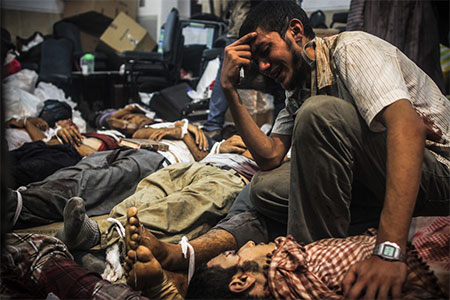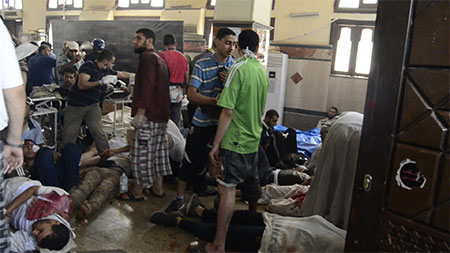

Security forces had identified the western side of Nasr Street as the "safe exit" for protesters in pre-recorded warnings. Instead, security forces fired tear gas, birdshot, and live rounds on protesters from the early morning. Some protesters responded by throwing rocks, Molotovs, and, in at least one instance, using a shotgun with birdshot.
Security forces arrived at around 6:15 – 6:30 a.m. Forces on the ground and snipers atop the Military Intelligence building in the adjacent army base began firing tear gas, but within minutes started using birdshot and live fire. By around 10 a.m., police forces had advanced to the Traffic Directorate Building, an Interior Ministry building. Some protesters responded by throwing rocks, Molotovs, and, in a few instances, using firearms.
Police forces advanced down this side street, beginning at around 6:20 a.m., but they were blocked by rows of cars and buses arranged by protesters. Police began lobbing teargas canisters at protesters, but within minutes escalated to firing birdshot and live bullets. Snipers fired from the Traffic Directorate Building, an Interior Ministry building on the street. Some protesters responded by throwing rocks, Molotovs, and, in a few instances, using firearms.
Security forces approached from the Republican Guard headquarters down Tayaran Street toward Rab'a Square. By 6:45 a.m., they began using teargas and live bullets on crowds of demonstrators. Witnesses recall seeing security forces arbitrarily shooting up and down northern Tayaran Street by 7:30 a.m. Security forces had neared the center of the sit-in by late morning.
Security forces advanced from the southern part of Tayaran Street, firing teargas and birdshot at demonstrators around 6:30-6:40 a.m., but by 7:30-8 a.m. were firing live bullets. Security forces fired at protesters inside the Manufiya Building, on Tayaran Street, and a nearby gas station. Some protesters responded by throwing rocks, Molotovs, and, in a few instances, using firearms.
I saw one man standing by the fountain in the middle of Nasr Street on Yousif Abbas. It was a tough scene. He took a bullet in his shoulder and fell. He tried to get up and got one in the leg. He began to crawl, as blood trickled down. He was the only person up front and kept taking bullets in the arm and chest. He took at least eight bullets. The bullet would come, he would shake, and then not move... We tried to drag him to safety, but weren't able to [for some time] because of the fire.
Two men stood to my left and right. They both fell to incoming fire. I was left in the middle. I was shocked—people were dying all around me and there was nothing I could do.
I tried to help whoever came back. I had Pepsi Cola, which I poured on the faces of those affected by gas. I was shot more than once in the face with birdshot. It hurt, but I could handle it. Right after that, I was hit by live rounds. Hollow point rounds in fact, they entered my arm and my chest. Two in the chest, one in the arm.
I was between two tents helping people to deal with tear gas. Fire was continuous. One second I felt an odd feeling in my leg, then pain in my pelvis. I was on Anwar al-Mufti [Street] turning to pick up a Pepsi bottle [used to mitigate effects of gas] and suddenly felt pain… I put my hand on my chest and felt it was hot… I saw blood on my hand and was heavily bleeding… The bullet came close to my heart.
They immediately fired tear gas and live fire. It was so intense, I can't even describe it; it was not like the other times before, one or two at a time. It was raining bullets. I smelled the gas and immediately saw people being hit and falling down around me. I have no idea how many people were hit. We didn't hear any warnings, nothing. It was like hell.

© 2013 Private
Protesters hurl rocks at security forces in the early morning on August 14, 2013.

© 2013 Tara Todras Whitehill
Tayaran street in Rab'a Square, at around 1pm on August 14, 2013.

A bus that was used as a blockade by protesters is seen burnt out the day after, on August 15, 2013.

© 2013 Private
A bulldozer clears tent encampments on Nasr Street during the dispersal of the sit-in on August 14, 2013.

Snipers positioned atop adjacent government buildings supported advancing forces and fired on crowds of demonstrators.
The center of Rab'a Square remained largely free from heavy teargas and gunfire until around 9:30 a.m. By late morning, advancing security forces and snipers began firing directly into the large mass of protesters in the center of the square.
There were bodies everywhere. There were so many bodies, and no way to treat them. There were men lying unable to move, many with internal bleeding, and nothing to do for them. We could barely walk among them. They couldn't do anything for [my friend] either; they were just overwhelmed.
I ran fast [out of the hospital] as bullets were flying. A guy stood in front of me to shield me from a bullet and fell on the sidewalk. I fell too and felt fire in my leg. I looked at him, and his face was not there. Blood was coming out of his neck.

© 2013 Mosa'ab El-shamy
The media center had been a central point for journalists during the sit-in before it was turned into a makeshift field hospital on August 14. By late morning, the media center was already "full of bodies, lined up side-by-side," an activist told Human Rights Watch.
Hall 3, which had been reserved for senior Muslim Brotherhood leaders during the sit-in, was the last facility to be turned into a makeshift hospital and morgue, but it too filled up. A medical student who treated patients at Hall 3 told Human Rights Watch that he received a "continuous stream" of bodies throughout the afternoon.

© 2013 Private
By late morning, the government hospital became the primary recipient of the injured and dead. Snipers firing live bullets from the adjacent Traffic Directorate Building targeted the main entrance to the hospital throughout the day, making it extremely dangerous to evacuate wounded out of the square. This area became known as "Sniper Alley."

© 2013 Private
Protesters had set up this makeshift medical facility in the early days of the sit-in, and this was the primary site where the injured and dead were brought in the early hours of the dispersal. Security forces began targeting the field hospital around 8:30 - 9 a.m. , forcing doctors to move the injured and corpses to other facilities, though it continued to operate even under intense fire. The building was set on fire around 6pm, likely by security forces, burning many of the corpses that were being held there.

© 2013 Private
The burned interior of the Rab'a Mosque on August 15, 2013, the day after the dispersal of the sit-in.
The mosque served as a refuge, particularly for women and children, for most of the day. A section of the mosque was used as a hospital and morgue. One protester, whose fiancé was killed during the dispersal, said that by 9:30 a.m. the mosque held so many corpses that it felt like it "had turned into a cemetery."
I stood by the building... it was 2:50 or 2:55 p.m. ... then suddenly I saw intense fire from all directions. For ten minutes, there was no one on the street. Then I saw a woman and man walking towards the security forces. They were the only people on the ground. Then I heard bullets and saw the woman on the ground. The man tried to carry her and also took a bullet and fell.
There was an officer who was standing in front of an APC... I told him I am a doctor and I am going inside to help... He had his gun with him and then he pointed it at me and said in a very loud voice "We will burn the place".
I threw rocks and tried to stop [the bulldozer's] advance. It entered and ran over bodies. Then I suddenly saw police officers run behind the bulldozers with guns... I was going to get hit, but someone pushed me out of the way. That saved my life. ... he took a bullet in his back that came out of his chest and he was martyred.
I saw three APCs in front of the hospital, from which police were firing. I was right there behind the [reception] desk and saw them hitting hard. I hid under the desk for protection. The fire continued for 15 minutes ... I thought death was near. I charged my phone and, with bullets flying by me, thought it was done and that I would die. I took out my phone and called my mom.
I heard one policeman yelling, "Hurry up; walk from here to there" and you could hear his voice trembling. There was a queue of [around six] men; they were walking with their hands on their heads. The policeman suddenly fired, and then I saw a man on the ground. He killed this man for nothing.
[The officer] kicked me and stepped on my head with his big boots. My face was all bloodied, but we were silent. Whoever spoke died. He jumped on my head and body. He stepped hard on my injured foot, and I stopped feeling it. They did the same things to others, as I saw. Next to me, there was an injured person: a 50-year-old with his guts out, as a result of gunfire. The soldier did the same thing to him that he did to me until he died. He hit him in the area of his injury, kicked him there.
Human Rights Watch documented 817 people killed during the Rab'a massacre. However, there is strong evidence that the actual death toll is likely at least 1000.

"I believe the number of corpses was close to 1000... we expected much more than what actually happened on the ground. The final outcome was less than we expected."
Hazem al-Beblawy, then-prime minister, to the Egyptian newspaper Al-Masry al-Youm on the dispersal of Rab'a and a smaller sit-in in al-Nahda Square in Giza.